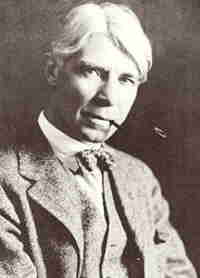 SKC Films Library SKC Films Library |
| SKC Films Library >> Linguistics, Languages, and Literatures >> American Literature >> 1900-1960 |
 Carl Sandburg Carl SandburgPulitzer Prize-winning poet, biographer, etc. Carl Sandburg was born in Galesburg, Illinois, on January 6, 1878, the son of poor Swedish immigrants. He left school at the age of 13 to work odd jobs to help support his family. At 17 he traveled west to Kansas as a hobo. He then served eight months in Puerto Rico during the Spanish-American War, but never saw combat. Returning to Galesburg in 1898, Sandburg was convinced by a friend to enroll in Lombard College. It was here that Sandburg was first encouraged to pursue poetry, by Professor Philip Green Wright, who also paid for the publication of Sandburg's first volume of poetry, Reckless Ecstasy (1904). Sandburg left Lombard in 1902 without receiving a degree. After college, Sandburg moved to Milwaukee, where he worked as an advertising writer and a newspaper reporter. He also became active in Socialist Party politics, working in the presidential campaign of Eugene V. Debs. He married Lillian Steichen in 1908. In 1913, Sandburg moved his family to a suburb of Chicago, where he became an editorial writer for the Chicago Daily News. In 1928, Sandburg moved his family to Harbert, Michigan. He moved again in 1943, this time to a farm in Flat Rock, North Carolina. He died in Flat Rock on July 22, 1967. His Poetry Sandburg's poetry first appeared in Harriet Monroe's magazine Poetry: A Magazine of Verse. Sandburg's first poetic success came with "Chicago" (1914), which portrays the brutality and ugliness he saw in Chicago cities. The Levinson Prize, awarded by Poetry in 1914, established Sandburg as an important new voice in literature. Chicago Poems (1916) was his first major collection of poems. Sandburg was too old to serve in the military during World War I, but he went abroad to serve as a foreign correspondent. He documented his war experiences in Cornhuskers (1918). In his dramatic short poems "Grass" (1918) and "A.E.F." (1920), Sandburg protested against the folly and waste of war. In his long free-verse poem The People, Yes (1936), Sandburg included tall tales about such fictional and real characters such as Paul Bunyan and Christopher Columbus. He ended the poem with the American people vigorously on the march, seeking new forms of self-expression, and asking the questions, "Where to? What next?" His Complete Poems (1950) won the 1951 Pulitzer Prize for Poetry. His Prose To Carl Sandburg, Abraham Lincoln represented all that was best in the American character, and the Civil War was the most important event in American history. From 1920 to 1939, he wrote six volumes of history about Lincoln and the Civil War. In Abraham Lincoln: The Prairie Years (two volumes, 1926), he dealt with Lincoln's career up to his election as President. Then, in Abraham Lincoln: The War Years (four volumes, 1939), he provided one of the fullest accounts of Lincoln's presidency ever written. For this work, Sandburg received the 1940 Pulitzer Prize for History. Other Works The Chicago Race Riots (1919) SOURCES SEE ALSO |
| SKC Films Library >> Linguistics,
Languages, and Literatures
>> American
Literature >> 1900-1960 This page was last updated on 05/25/2017. |